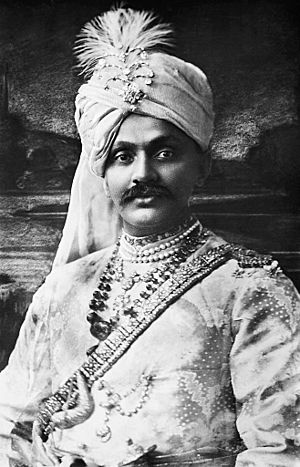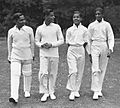Ranjitsinhji facts for kids
Quick facts for kids Ranjitsinhji Vibhaji II |
||||||||||||||||||||||||||||||||||||||||||||||||||||||||||||||||||||||||||
|---|---|---|---|---|---|---|---|---|---|---|---|---|---|---|---|---|---|---|---|---|---|---|---|---|---|---|---|---|---|---|---|---|---|---|---|---|---|---|---|---|---|---|---|---|---|---|---|---|---|---|---|---|---|---|---|---|---|---|---|---|---|---|---|---|---|---|---|---|---|---|---|---|---|---|
| Jam Sahib of Nawanagar | ||||||||||||||||||||||||||||||||||||||||||||||||||||||||||||||||||||||||||
 |
||||||||||||||||||||||||||||||||||||||||||||||||||||||||||||||||||||||||||
| Maharaja of Nawanagar | ||||||||||||||||||||||||||||||||||||||||||||||||||||||||||||||||||||||||||
| Reign | 1907–1933 | |||||||||||||||||||||||||||||||||||||||||||||||||||||||||||||||||||||||||
| Predecessor | Jashwantsinhji Vibhaji II | |||||||||||||||||||||||||||||||||||||||||||||||||||||||||||||||||||||||||
| Successor | Digvijaysinhji Ranjitsinhji | |||||||||||||||||||||||||||||||||||||||||||||||||||||||||||||||||||||||||
| Born | 10 September 1872 Sadodar, Kathiawar, Bombay Presidency, British India |
|||||||||||||||||||||||||||||||||||||||||||||||||||||||||||||||||||||||||
| Died | 2 April 1933 (aged 60) Jamnagar Palace, Nawanagar State, Bombay Presidency, British India |
|||||||||||||||||||||||||||||||||||||||||||||||||||||||||||||||||||||||||
| Alma mater | Cambridge University | |||||||||||||||||||||||||||||||||||||||||||||||||||||||||||||||||||||||||
|
||||||||||||||||||||||||||||||||||||||||||||||||||||||||||||||||||||||||||
Ranjitsinhji Vibhaji II (born September 10, 1872 – died April 2, 1933) was an important figure in both Indian history and cricket. He was the ruler of the Indian state of Nawanagar from 1907 to 1933. He was also a famous Test cricket player for the English cricket team. People often called him Ranji or K. S. Ranjitsinhji.
Ranji is seen as one of the best batsmen of his time. He changed how cricket was played with his unique style and quick reactions. He was known for a special shot called the leg glance. This shot involved flicking the ball behind his legs.
In India, a major cricket tournament, the Ranji Trophy, is named after him. It was started in 1935. His nephew, Duleepsinhji, also became a famous cricketer for England.
Besides cricket, Ranji became the Maharaja Jam Saheb of Nawanagar. He also worked as the leader of the Indian Chamber of Princes. He even represented India at the League of Nations, which was an early version of the United Nations.
Contents
Early Life and Becoming a Ruler
Birth and Family
Ranjitsinhji Jadeja was born on September 10, 1872. He was born in Sadodar, a village in the state of Nawanagar, India. His family was related to the rulers of Nawanagar. His name means "the lion who conquers in battle."
Becoming Heir to the Throne
In 1877, the ruler of Nawanagar, Vibhaji, chose Ranjitsinhji as his heir. This happened because Vibhaji's own son, Kalubha, was not suitable to rule. Ranjitsinhji moved to Rajkot to get approval from the British rulers.
However, in 1882, Vibhaji had another son, Jaswantsinhji. This meant Ranjitsinhji was no longer the heir. The British authorities still wanted to support Ranjitsinhji. They believed he had great potential.
Education and Cricket Beginnings
Ranjitsinhji continued his education at the Rajkumar College. This school was run like an English public school. He started playing cricket around age 10 or 11. He became captain of the school team in 1884.
He later moved to England to study at Cambridge University. In London, he watched a cricket match and was amazed by the high level of play. This made him want to become a better cricketer.
Cambridge University Cricket
Focus on Cricket
At Cambridge, Ranjitsinhji focused more on sports than on his studies. He wanted to earn a "Blue" (a sports award) in tennis at first. But after seeing the high-level cricket in England, he decided to focus on cricket instead.
He joined the Cambridgeshire County Cricket Club in 1891. He worked hard to improve his batting skills. He practiced with a coach, Daniel Hayward, who helped him develop his unique leg glance shot. This shot became his trademark.
Playing for Cambridge University
In 1892, Ranjitsinhji started playing for Trinity College, Cambridge. He quickly showed his talent. In 1893, he made his first-class cricket debut for Cambridge University. He played well against strong teams, including the touring Australian team.
His batting impressed many people. He was given his "Blue" award for cricket. His friends at Cambridge gave him the nickname "Ranji," which stuck with him for life. He became very popular.
However, Ranjitsinhji faced financial problems. He had to leave Cambridge University in 1894 without finishing his degree.
Playing for Sussex and England
County Debut with Sussex
After leaving Cambridge, Ranjitsinhji began playing for Sussex. He made his debut in 1895. In his first game, he scored 77 not out and then his first century (150 runs). Crowds loved his exciting batting style.
He became very popular and helped increase attendance at matches. He was known for his brilliant shots, especially on the leg side. He scored 1,775 runs that season, placing him among the top batsmen in the country.
Succession Questions and a Cricket Book
In 1895, the ruler of Nawanagar, Vibhaji, died. His 12-year-old son, Jaswantsinhji, became the new ruler. However, Ranjitsinhji started to explore his own claim to the throne.
His fame grew, and he wrote a successful cricket book called The Jubilee Book of Cricket in 1897. This book was praised by critics.
Touring Australia
Ranjitsinhji was chosen to play for England in Australia during the 1897–98 winter. He was one of the few English players who did well. He scored 175 runs in his first Test match, which was the highest score for England at that time.
He scored 457 runs in the series, showing his skill against tough Australian bowlers. He was very popular with the Australian public.
Cricket Peak and Challenges
Return to India and Financial Support
In 1898, Ranjitsinhji returned to India. He wanted to pursue his claim to the Nawanagar throne. He gained support from other Indian princes, including Rajinder Singh, the Maharaja of Patiala, who provided him with money.
He traveled across India, meeting people and playing cricket. The British administration was concerned about his activities. They increased his allowance, but he still wanted to be the ruler. His claim was eventually rejected by the British.
Record-Breaking Seasons
When Ranjitsinhji returned to England in 1899, he played cricket with new determination. He scored 3,159 runs that season, becoming the first batsman to score over 3,000 first-class runs in a single season. He hit eight centuries.
In June 1899, he became the captain of Sussex. He was praised for his leadership. In 1900, he continued to score heavily, making 3,065 runs and leading the national batting averages. He changed his batting style to adapt to new tactics from opposing teams.
Challenges in 1902
By 1901, Ranjitsinhji faced financial difficulties again. This affected his cricket performance in 1902. He seemed nervous and struggled to concentrate during matches, especially in the Test series against Australia.
He played only a few more games that season and then left the Sussex team. He never played for England again after the 1902 series.
Later Cricket Years
Ranjitsinhji continued to play cricket regularly until 1904. He had another excellent season in 1904, leading the batting averages with 2,077 runs. He scored eight centuries and five half-centuries.
His career as a regular cricketer ended after the 1904 season. He returned to England in 1908 and 1912 for short periods to play cricket. In 1920, he played his last first-class matches after losing an eye in a hunting accident. He found it hard to focus on the ball.
In total, Ranjitsinhji scored 24,692 runs in first-class cricket. His average of 56.37 was one of the highest for a batsman based in England for many years. He scored 72 centuries.
Jam Sahib of Nawanagar
Becoming the Ruler
In 1906, the ruler Jassaji died. After a long discussion, the British decided that Ranjitsinhji would be the next ruler. This was partly because of his popularity as a cricketer and his connections with British officials.
Ranjitsinhji became the Jam Sahib of Nawanagar on March 11, 1907. He faced many challenges because the state was poor and suffered from disease. He wanted to modernize Nawanagar.
First Years as Ruler
Ranjitsinhji worked to improve Nawanagar. He tried to increase the state's income and began building a cricket pitch. He also ordered his army to deal with rebellions in some villages.
He made trips to England, which sometimes caused concern among British officials. He continued to face financial issues, but he managed to handle them.
War Service and Injury
When World War I started in 1914, Ranjitsinhji offered his state's resources to Britain. He became an honorary major in the British Army. In 1915, he was accidentally shot in the right eye during a hunting trip. His eye was badly damaged and had to be removed.
Final Years and Legacy
Improvements in Nawanagar
While Ranjitsinhji was away during the war, his administrator, Berthon, began modernizing Nawanagar. Slums were cleared, and new houses, shops, and roads were built. Irrigation was improved, which helped during dry weather. The state's finances also got much better.
A new port was built at Bedi, which greatly increased Nawanagar's income. This allowed Ranjitsinhji to live in luxury. He bought many properties, including a castle in Ireland. He began splitting his time between India and the British Isles.
Supporting Indian Princes
In his later years, Ranjitsinhji worked to support the interests of Indian princes. He helped create the Chamber of Princes. He also represented India at the League of Nations from 1920 to 1923. He was known for his generous hospitality and influential speeches.
He faced criticism for being an "absentee ruler" and for high taxes in Nawanagar. He tried to answer these criticisms through books published by others.
Death and Lasting Impact
Ranjitsinhji died on April 2, 1933, from heart failure. His ashes were scattered over the River Ganges.
His impact on cricket was huge. He is remembered as one of the most original and stylish batsmen ever. The Ranji Trophy, India's main first-class cricket tournament, was named in his honor.
As a ruler, he modernized his capital, built roads and railways, and developed a major port. He is considered one of the best cricketers in Indian history and a legendary player for the Sussex County Cricket Club.
Playing Style
Ranjitsinhji's batting was seen as very new and different in his time. He is known as one of the most unique batsmen in cricket history. His friend and captain, C. B. Fry, said his style came from his perfect balance and quickness. Cricket writer Neville Cardus said Ranji brought a "strange light from the East" to English cricket.
Titles
His full title was Colonel His Highness Shri Sir Ranjitsinhji Vibhaji II, Jam Saheb of Nawanagar, GCSI, GBE.
Legacy
Ranjitsinhji was important in bringing people together across the British Empire. His image was used in advertisements in England and Australia. This showed how popular he was, especially after facing some prejudice early in his career.
His popularity as an Indian playing cricket for England was remarkable. W. G. Grace, another cricket legend, said Ranji's fame came from his amazing batting skills and his nationality.
After his death, the Board of Control for Cricket in India (BCCI) started the Ranji Trophy in 1934. This trophy was given by Maharaja Bhupinder Singh of Patiala. Today, it is still a major cricket championship in India.
As a ruler, he made many improvements. He rebuilt his capital city, built roads and railways, and created a modern port. Because of his achievements in cricket, he is seen as one of India's best cricketers and one of the greatest batsmen for the Sussex County Cricket Club.
Images for kids









